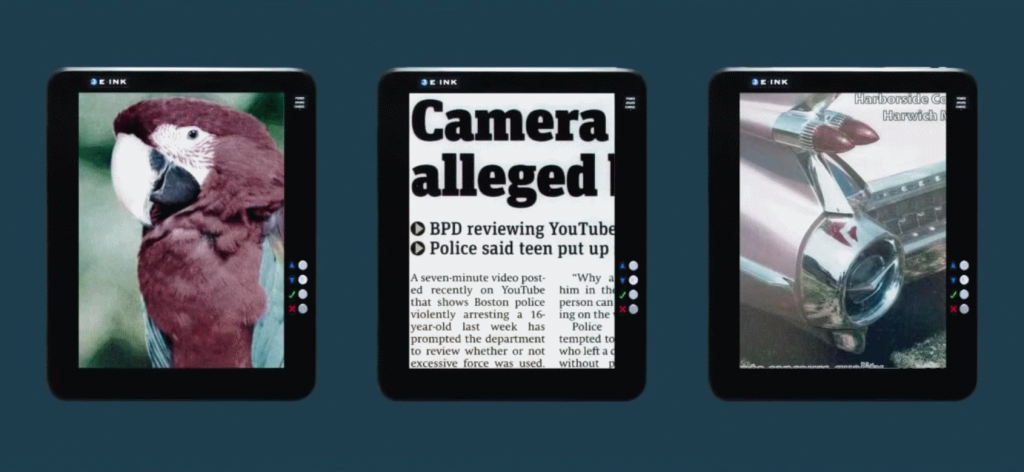

Electronic paper colors traffic, retail and more
Visionect, 18 May 2015
We continue our series on the how and why of electronic paper by turning from its history, technology and development to that most coveted of e-ink signage: electronic paper displays capable of showing color.
While the arranging of small black and white particles in different distances to the surface of the display is perfect for black and white or grayscale images, it poses a challenge when trying to show things in color.
If there is one performance dimension of e-ink that seems to forever be on the tip of people’s tongues, it is the question of an e-paper display being capable of showing color.
And no wonder: with a range of applications in e-books, retail, traffic, wayfinding and more, all that the energy-saving, perfectly-visible electronic paper displays seem to have been missing is the ability to show the bright images of a graphic novel or picture book, the red of a stop sign, or the multi-colored images of a commercial billboard.
Why is color e-paper so elusive?
To better understand the road to a viable color e-paper display (EPD for short), we must first understand how electronic paper technology actually works. If you’re already familiar with this, feel free to skip this section and continue reading all about the engineering challenges of color EPD development.
An e-paper screen differs from other displays in that it can hold images in perpetuity without power. This is possible because the screen itself is made up of differently-colored tiny particles the size of a human hair. The particles have either a positive or negative charge and are located in small capsules laid over an electric array. The array creates a number of electric fields per square inch of the screen; if the field is negative, the particles with the positive charge will rise to the surface of the display to be seen. If the field is positive, the negative particles become visible.
While this is perfect for creating resilient monochrome and even grayscale images, where teeny-tiny black and white particles arrange in different distances to the surface of the display to form an image, it poses a problem when trying to show things in color. How do you show all the colors of the rainbow with just two shades of particles available?

From the very beginnings of the technology, the creation of commercially-available color electronic paper displays has been the goal of all EPD manufacturers (image source:
An engineering challenge
Developing color electronic paper has always posed an engineering challenge that has seen many different technological approaches in the race to create a consumer-ready tinted e-paper display.
Developing color electronic paper has always posed an engineering challenge.
A clever solution by E Ink®, for example, solved the black and white dilemma by introducing a third color, red, which carries the same charge as the black particles of the display film, but rises to the surface under different voltage.
Meanwhile some of the other attempts at translating e-paper into color included reimagining the technology itself.
SEARCHING FOR THE BEST SOLUTION
The most widely implemented electronic paper technology of today is electrophoretic, meaning that it functions on the basis of the motion of dispersed particles in a fluid under the influence of an electric field. To make e-ink show color, an in-plane electrophoretic display was created, which featured two capsules for each pixel of the screen: one capsule containing yellow and cyan particles, the other magenta and black. By controlling the voltage the screen could display whichever color moved to the surface of the pixel, or turn white by having all the particles move away from the surface.
Another e-paper innovation are electrofluidic displays, using electricity to move pigmented fluids around the display surface. Voltage is used to pull the pigment out of tiny reservoirs forming a small part of the viewable pixel area, spreading the pigment as a film behind the viewing substrate, with the display taking on the pigment’s color.
Presented in Technicolor
The most widely-used solution, however, has proven to be electronic paper displays that show color by combining traditional black and white screens with different types of color filters; this is not unlike early film’s Technicolor process, which simultaneously exposed two frames of a single strip of black and white film, one behind a green filter and one behind a red filter, to show a movie in color.
The most viable solution on the market has proven to be electronic paper displays that show color by combining a black and white screen with a color filter, not unlike early film’s Technicolor process.
E Ink’s color display, the Triton, for example uses a thin color optical filter on the top layer of an ordinary black and white EPD. The filter’s pixels are divided into groups of three phosphor dots coloured red, green, and blue: when the correct charge is applied and the white particles of the black and white display move to its surface, they will reflect ambient light, causing the embedded RGBW filter to reflect color back to the reader by combining red, green and blue.
From traffic signs to maps
And the uses of color electronic paper technology?
Just imagine smart commercial billboards that can hold bright, vivid colors even without electricity, continuously refreshing the information shown on very little power. Not to mention traffic signs powered by a solar cell that can display all the colors necessary in notifying drivers of road rules, flashing important timely warnings instantly, updated from a central location; or e-picture books and color-coded interactive subway maps that don’t have any glare.
Just like Technicolor and the new era of cinema it ushered in, color e-ink will no doubt mean a new chapter in digital signage, with its applications in indoor as well as outdoor use (remember e-paper’s amazing readability!) more than versatile.
Tags

